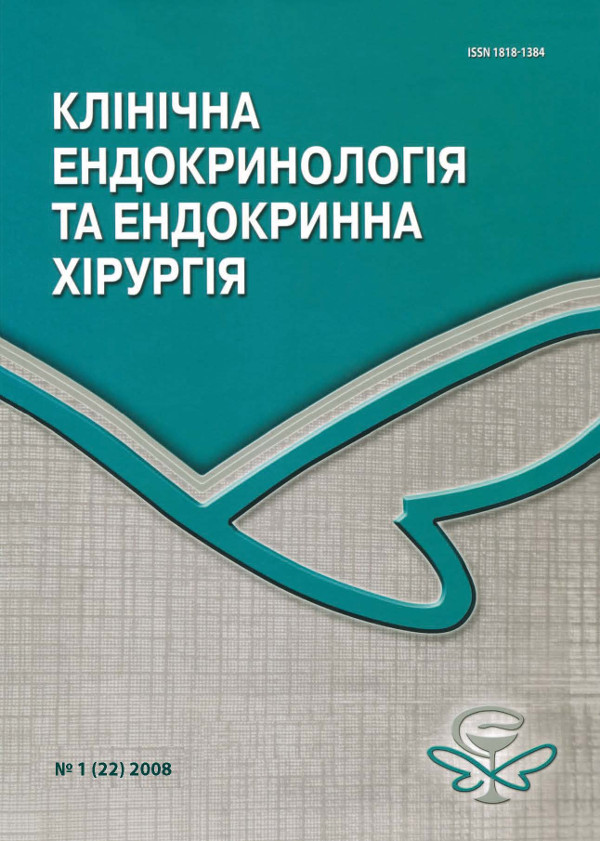Розчинний рецептор кінцевих продуктів посиленого глікування у хворих на цукровий діабет 2-го типу: зв'язок з інсулінорезистентністю
DOI:
https://doi.org/10.24026/1818-1384.1(22).2008.118399Ключові слова:
soluble receptor for advanced glycation end-products, type 2 diabetes mellitus, insulin resistanceАнотація
31 middle-age patients with type 2 diabetes mellitus, dysglicaemia, dyslipidaemia and overweight or obesity were observed. Under renal insufficiency absence there were not reliable changes of the soluble receptor for advanced glycation end-products (sRAGE) level. However, the indirect correlations of sRAGE with hyperglycaemia, hormonal and metabolic factors of insulin resistance, iron homoeostasis and low grade inflammation parameters were found. The indirect association of sRAGE with pathogenic markers of insulin resistance and atherogenesis suggests their counteracting effect on the synthesis of the endogenous RAGE inhibitor. Strong direct correlation of sRAGE with antiatherogenic markers grounds use of this index for type 2 diabetes mellitus monitoring and diabetic vascular complications therapy.Посилання
Bucciarelli L.G., Wendt T., Rong L. et al. RAGE is a multiligand receptor of the immunoglobulin superfamily: implications for homeostasis and chronic disease // Cell Mol. Life Sci. — 2002. — Vol. 59. — P. 1117-1128.
Schlueter C., Hauke S., Flohr A.M. et al. Tissue specific expression patterns of the RAGE receptor and its soluble form — a result of regulated alternative splicing? // Biochem. Biophys. Acta. — 2003. — Vol. 1639. — P. 1-6.
Neeper M., Schmidt A.M., Brett J. et al. Cloning and Expression of a cell surface receptor for advanced glycosylation end products of proteins // J. Biol. Chem. — 1992. — Vol. 267. — P. 14998-15004.
Bierhaus A., Humpert P.M., Morcos M. et al. Understanding RAGE, the receptor for advanced glycation end products // J. Mol. Med. — 2005. — Vol. 83. — P. 876-886.
Singh R., Barden A., Mori T., Beilin L. Advanced glycation end-products: a review // Diabetologia. — 2001. — Vol. 44, No 2. — P. 129—146.
Stern D.M., Yan S.D., Yan S.F., Schmidt A.M. Receptor for advanced glycation endproducts (RAGE) and the complications of diabetes // Ageing Res. Rev. — 2002. — Vol. 1, No 1. — P. 1-15.
Yamamoto Y., Yamagishi S., Yonekura H. et al. Roles of the AGE-RAGE system in vascular injury in diabetes // Ann. N. Y. Acad. Sci. — 2000. — Vol. 902. — P. 163-170.
Basta G., Lazzerini G., Massaro M. et al. Advanced glycation end products activate endothelium through signal-transduction receptor RAGE: a mechanism for amplification of inflammatory responses // Circulation. — 2002. — Vol. 105. — P. 816-822.
Tanaka N., Yonekura H., Yamagishi S. et al. The receptor for advanced glycation end producs is induced by the glycation product themselves and tumor necrosis factor-α through nuclear factor-κ B, and by 17β-estradiol through Sp-1 in human vascular endothelial cells // J. Biol. Chem. — 2000. — Vol. 275. — P. 25781-25790.
Hudson B.I., Bucciarelli L.G., Wendt T. et al. Blockade of receptor for advanced glycation endproducs: a new target for therapeutic intervention in diabetic complications and inflammatory disorders // Arch. Biochem. Biophys. — 2003. — Vol. 419. — P. 80-88.
Goosa M.T., Li J., Kislinger T. et al. Blockade of receptor for Advanced Glycation Endproducts restores effective wound healing in diabetic mice // Amer. J. Pathol. — 2001 — Vol. 159. — P. 513-525.
Kalousova M., Hodkova M., Kazderova M. et al. Soluble receptor for advanced glycation end products in patients with decreased renal function // Amer. J. Kidney Dis. — 2006. — Vol. 47. — P. 406-411.
Tan K.C.B., Shiu S.W.M., Chow W.S. et al. Association between serum levels of soluble receptor for advanced glycation end products and circulating advanced glycation end products in type 2 diabetes // Diabetologia. — 2006. — Vol. 49, No 11. — P. 2756-2762.
Challier M., Jacqueminet S., Benabdesselam O. et al. Increased serum concentration of soluble receptor for advanced glycation endproducts in patients with type 1 diabetes // Clin. Chem. — 2005. — Vol. 51. — P. 1749-1750.
Basta G., Sironi A.M., Lazzerini G. et al. Circulating soluble receptor for advanced glycation end products is inversely associated with glycemic control and S100A12 protein // J. Clin. Endocrinol. Metab. — 2006. — Vol. 91. — P. 4528-4534.
Tan K.C.B., Chow W.S., Tso A.W.K. et al. Thiazolidinedione increases serum soluble receptor for advanced glycation end-products in type 2 diabetes // Diabetologia. — 2007. — Vol. 50, No 9. — P. 1819-1825.
Matthews D.R., Hosker J.P., Rudenski A.S. et al. Homeostasis model assessment: insulin resistance and β-cell function from fasting plasma glucose and insulin concentrations in man // Diabetologia. — 1985. — Vol. 28. — P. 412-419.
Matsuhisa M., Yamasaki Y., Emoto M. et al. A novel index of insulin resistance determined from the homeostasis model assessment index and adiponectin levels in Japanese subjects // Diabetes Res. Clin. Pract. — 2007. — Vol. 77. — P. 151-154.
Katz A., Nambi S.S. Mather K. et al. Quantitative insulin sensitivity check index: a simple, accurate method for assessing insulin sensitivity in humans // J Clin Endocrin Metab. — 2000. — Vol. 85. — P. 2402-2410.
Inoue M., Yano M., Yamakado M. et al. Relationship between the adiponectin-leptin ratio and parameters of insulin resistance in subjects without hyperglycemia // Metabolism. — 2006. — Vol. 55. — P. 1248-1254.
Hudson B.I., Harja E., Moser B., Schmidt A.M. Soluble levels of receptor for advanced glycation endproducs (sRAGE) and coronary artery disease: the next C-reactive protein? // Arterioscler. Thromb. Vasc. Biol. — 2005. — Vol. 25. — P. 897-882.
Koyama H., Shoji T., Yokoyama H. et al. Plasma level of endogenous secretory RAGE is associated with components of the metabolic syndrome and atherosclerosis // Arterioscler. Thromb. Vasc. Biol. — 2005. — Vol. 25. — P. 2587-2593.
Dimascio L., Voermans C., Uqoezwa M. et al. Identification of adiponectin as a novel hemopoetic stem cell growth factor // J. Immunol. — 2007. — Vol. 178, No 6. — P. 3511-3520.
##submission.downloads##
Опубліковано
Як цитувати
Номер
Розділ
Ліцензія

Ця робота ліцензується відповідно до Creative Commons Attribution-NonCommercial 4.0 International License.





